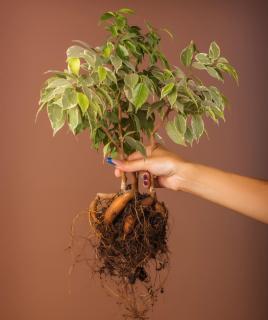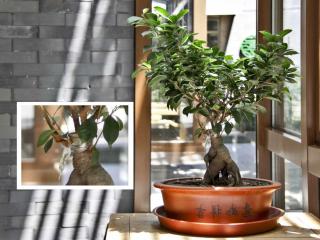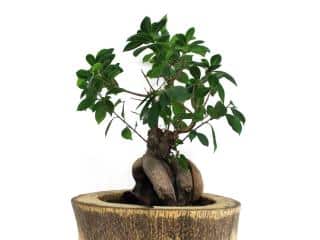

Most Ficus ginseng bonsai are grafted Ficus microcarpa.
Key grafted ficus bonsai facts
Rootstock: Ficus microcarpa
Scion: retusa, benjamina, microcarpa
Type of graft: cleft graft / bark graft
Bonsai mastery: beginner
Lifespan: decades (resilient)
Feature: aerial roots – Care: very easy – Repotting: yearly
A grafted ficus combines bulging roots of Ficus microcarpa with glossy leaves of other fig species. This is the Origin Story of this famous fleshy-rooted bonsai.
Surprisingly, most store-bought ficus bonsai aren’t prepared in ancient bonsai master schools. They’re grown and grafted in nurseries by the thousands in tropical regions of the world.
This helps make out favorite little ficus affordable for all! First, nice rootstock with thick roots are prepared, and then varieties of ficus with elegant foliage are grafted onto it.
Ficus microcarpa, the Chinese banyan, naturally grows thick, bulging roots. This explains one of this species’ common names, “pot-bellied ficus“.
 In most cases, roots start growing underground from a seedling or cutting.
In most cases, roots start growing underground from a seedling or cutting.When preparing the usual “Ficus ginseng” bonsai, each F. microcarpa sapling is pulled out to expose the roots. The long, spindly stem is cut off just above the thick bunch of roots.
Roots are cleaned and then gently set atop fresh soil mix, higher up than they were buried. At this point, they:
From the cut trunk, new side branches will sprout for non-grafted specimens.
Indeed, F. microcarpa varieties with the most appealing roots don’t always have very appealing leaves, and vice-versa.

Nearly all fig tree species can be grafted onto one another.
Older branches are grafted at the cut mark. Typically, 3 to 5 scions are grafted using either the cleft or the bark graft technique. They shoot upwards from the graft, giving the tree a more “umbrella-like” appearance.
It usually looks less cluttered and nicer. Bonsai Ficus microcarpa grown this way are easier to maintain.
When pruning, you’ll always have to choose between favoring the rootstock shoots or the scions.

Out of curiosity, we suggest trying to let one rootstock shoot grow freely until it is just under a foot long (20-30 cm).
If you like the leaves more than those of the scions, start training that offshoot and cut the grafted scions back:
Whichever you choose, keep pruning and trimming the same branches as the main, structural branches for your ficus bonsai.
For denser foliage, every year, perform 3 important steps in spring:
Also, consider supporting aerial root growth, since they’re part of what makes the ficus bonsai so special.